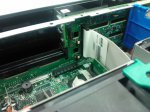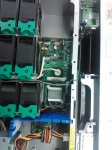David3D
Explorer
- Joined
- Sep 10, 2013
- Messages
- 56
Hi Guys,
DISCLAIMER: Before anyone goes off-topic, I am well aware that I am operating BELOW many of the current recommended FreeNAS standards such as the memory rule. The idea behind updating hardware is to bring the standards up as well as the stability. I don't have unlimited money unfortunately, so I make do.
I've got a confusing situation I'd like help with regarding backplanes, midplanes, SATA and SAS drives...etc. I have two INTEL SR2500's. One with a SATA backplane and the other with what I think is a SAS midplane as it seems totally different to what was refered to as the backplane on the other SR2500.
Information that may be of use:
NEW SR2500
Intel Product code SR2500
System Board S5000XALR
Manual: http://download.intel.com/support/motherboards/server/sb/sr2500_tps_1_6.pdf
OLD SR2500
Chassis: SR2500
Motherboard: SE7520JR2
All attached images are of new hardware. Old hardware is in service and I can't access it easily while it is running unfortunately.
Both SR2500's are different with regards to specs. The current one on active duty I believe is significantly older. It only supports DDR memory of which it only has 2GB with 2 SATA ports on the board. The new SR2500 has 6 SATA ports and 4GB of DDR2 memory. The idea was to migrate the oldest hardware on to the slightly newer, more stable, more workable hardware.
On the current SR2500 on duty, I have 2 disks in RAID via the Intel board and an additional hardware RAID card with an additional 4 disks attached to that. I've since learned that RAID cards are a bad idea and want to attach all disks directly to the new board.
To be more specific: I have two 3TB WD Red disks in RAID 1 on the Intel board with another two 1TB Red drives in RAID 1 one on the RAID card. I have two additional drives attached to the RAID card for other tasks that are for random stuff that is not important that I don't back up but wanted to keep separate from the rest of the important stuff that I do.
I combined them via hardware as I understood it was more memory/processor intensive to mirror information via ZFS. I'm unaware if this is actually true and if I am actually doing it the wrong way, but this is what I want to fix ultimately.
The current SR2500 has a SATA backplane where one side has media connected and on the directly opposite side is the data cable connector in order for the cable to be connected to that particular drive and corresponding port on the board or RAID card. On the NEW SR2500, I have several bays with a what looks like a SATA backplane, but there is also this device called a "midplane" which does not actually allow me to connect any SATA devices to it. It looks as if there is one SATA connector on the rear of the backplane. I'm not actually sure what the midplane is designed to do.
I've got a funny feeling I have a SAS backplane with a midplane in the middle. I was thinking...I could transplant the new motherboard from the new SR2500 in to the older chassis with the SATA backplane in order to achieve the same setup I have right now. Or perhaps the backplane from the old chassis in to the new chassis in order to do the same thing again. Not sure if it would work since they are two different models.
The whole point of this exercise is as follows:
- To have identical or similar redundant hardware in case of immediate failure.
- To increase the availability of parts and decrease the cost of upgrading within scope of my limited budget (DDR is expensive!)
- To increase stability over-all and of course better the ability to access data at speed.
I have identical hardware (somewhat) in order to counter failure...I have a board, fans, caddies, drives...ect...
I have daily backups of information which is MOST important and weekly backups of ALL information. The rest is in the cloud. I am hoping ALL will be cloud based by the time 100/100 fibre hits our door later this month.
Thank you for reading my wall of text. I hope I can get somewhere with this.
EDIT: Formatting/Spelling
Cheers,
David
DISCLAIMER: Before anyone goes off-topic, I am well aware that I am operating BELOW many of the current recommended FreeNAS standards such as the memory rule. The idea behind updating hardware is to bring the standards up as well as the stability. I don't have unlimited money unfortunately, so I make do.
I've got a confusing situation I'd like help with regarding backplanes, midplanes, SATA and SAS drives...etc. I have two INTEL SR2500's. One with a SATA backplane and the other with what I think is a SAS midplane as it seems totally different to what was refered to as the backplane on the other SR2500.
Information that may be of use:
NEW SR2500
Intel Product code SR2500
System Board S5000XALR
Manual: http://download.intel.com/support/motherboards/server/sb/sr2500_tps_1_6.pdf
OLD SR2500
Chassis: SR2500
Motherboard: SE7520JR2
All attached images are of new hardware. Old hardware is in service and I can't access it easily while it is running unfortunately.
Both SR2500's are different with regards to specs. The current one on active duty I believe is significantly older. It only supports DDR memory of which it only has 2GB with 2 SATA ports on the board. The new SR2500 has 6 SATA ports and 4GB of DDR2 memory. The idea was to migrate the oldest hardware on to the slightly newer, more stable, more workable hardware.
On the current SR2500 on duty, I have 2 disks in RAID via the Intel board and an additional hardware RAID card with an additional 4 disks attached to that. I've since learned that RAID cards are a bad idea and want to attach all disks directly to the new board.
To be more specific: I have two 3TB WD Red disks in RAID 1 on the Intel board with another two 1TB Red drives in RAID 1 one on the RAID card. I have two additional drives attached to the RAID card for other tasks that are for random stuff that is not important that I don't back up but wanted to keep separate from the rest of the important stuff that I do.
I combined them via hardware as I understood it was more memory/processor intensive to mirror information via ZFS. I'm unaware if this is actually true and if I am actually doing it the wrong way, but this is what I want to fix ultimately.
The current SR2500 has a SATA backplane where one side has media connected and on the directly opposite side is the data cable connector in order for the cable to be connected to that particular drive and corresponding port on the board or RAID card. On the NEW SR2500, I have several bays with a what looks like a SATA backplane, but there is also this device called a "midplane" which does not actually allow me to connect any SATA devices to it. It looks as if there is one SATA connector on the rear of the backplane. I'm not actually sure what the midplane is designed to do.
I've got a funny feeling I have a SAS backplane with a midplane in the middle. I was thinking...I could transplant the new motherboard from the new SR2500 in to the older chassis with the SATA backplane in order to achieve the same setup I have right now. Or perhaps the backplane from the old chassis in to the new chassis in order to do the same thing again. Not sure if it would work since they are two different models.
The whole point of this exercise is as follows:
- To have identical or similar redundant hardware in case of immediate failure.
- To increase the availability of parts and decrease the cost of upgrading within scope of my limited budget (DDR is expensive!)
- To increase stability over-all and of course better the ability to access data at speed.
I have identical hardware (somewhat) in order to counter failure...I have a board, fans, caddies, drives...ect...
I have daily backups of information which is MOST important and weekly backups of ALL information. The rest is in the cloud. I am hoping ALL will be cloud based by the time 100/100 fibre hits our door later this month.
Thank you for reading my wall of text. I hope I can get somewhere with this.
EDIT: Formatting/Spelling
Cheers,
David



